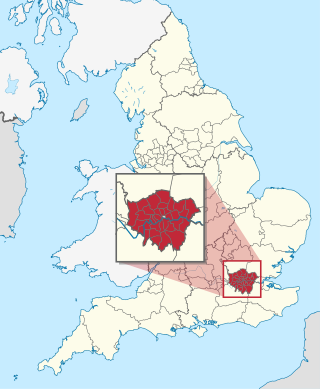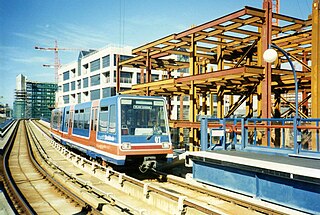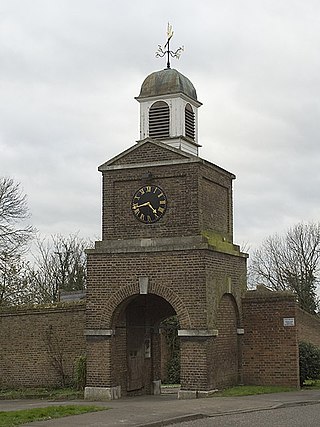Related Research Articles

The London boroughs are the 32 local authority districts that together with the City of London make up the administrative area of Greater London, England; each is governed by a London borough council. The present London boroughs were all created at the same time as Greater London on 1 April 1965 by the London Government Act 1963 and are a type of local government district. Twelve were designated as Inner London boroughs and twenty as Outer London boroughs. The City of London, the historic centre, is a separate ceremonial county and sui generis local government district that functions quite differently from a London borough. However, the two counties together comprise the administrative area of Greater London as well as the London Region, all of which is also governed by the Greater London Authority, under the Mayor of London.

Thurrock is a unitary authority area with borough status in the ceremonial county of Essex, England. It lies on the north bank of the River Thames immediately east of London and has over 18 miles (29 km) of riverfront including the Port of Tilbury, the principal port for London. Thurrock is within the London commuter belt and is an area of regeneration within the Thames Gateway redevelopment zone. The borough includes the northern ends of the Dartford Crossing.

Thames Gateway is a term applied to an area around the Thames Estuary in the context of discourse around regeneration and further urbanisation. The term was first coined by the UK government and applies to an area of land stretching 70 kilometres (43 mi) east from inner east and south-east London on both sides of the River Thames and the Thames Estuary. It stretches from Westferry in Tower Hamlets to the Isle of Sheppey/Southend-on-Sea and extends across three ceremonial counties.

The London Docklands Development Corporation (LDDC) was a quango agency set up by the UK Government in 1981 to regenerate the depressed Docklands area of east London. During its seventeen-year existence, it was responsible for regenerating an area of 8.5 square miles (22 km2) in the London Boroughs of Newham, Tower Hamlets and Southwark. LDDC helped to create Canary Wharf, Surrey Quays shopping centre, London City Airport, ExCeL Exhibition Centre, London Arena and the Docklands Light Railway, bringing more than 120,000 new jobs to the Docklands and making the area highly sought after for housing. Although initially fiercely resisted by local councils and residents, today it is generally regarded as having been a success and is now used as an example of large-scale regeneration, although tensions between older and more recent residents remain.

The Borough of Basildon is a local government district with borough status in Essex, England. It is named after its largest town, Basildon, where the council is based. The borough also includes the towns of Billericay and Wickford and surrounding rural areas.

The Thames Gateway Bridge was a proposed crossing over the River Thames in east London, England. It was first mooted in the 1970s but never came to fruition. The concept was re-proposed in 2004, with preliminary planning proceeding until November 2008, when Boris Johnson, the then Mayor of London, formally cancelled the entire £500 million scheme.

Chafford Hundred is an area in the Borough of Thurrock in the ceremonial county of Essex, England. Chafford Hundred is north-west of Grays.

Purfleet-on-Thames is a town in the Thurrock unitary authority, Essex, England.
English Partnerships (EP) was the national regeneration agency for England, performing a similar role on a national level to that fulfilled by regional development agencies on a regional level. On 1 December 2008 its powers passed to a successor body, the new Homes and Communities Agency.

The London Riverside is a redevelopment area on the north side of the River Thames in East London, England. The area was identified as a zone of change following the introduction of the Thames Gateway policy in 1995. Proposals for improvements in the area were at first developed by Havering and Barking and Dagenham councils, with a London Riverside Urban Strategy published in 2002. This was incorporated into the first London Plan published by the Mayor of London in 2004. Between 2004 and 2013 the planning powers in London Riverside and the Lower Lea Valley were the responsibility of the London Thames Gateway Development Corporation. Planning powers have now reverted to the local councils. Much of the land available for redevelopment is now owned by GLA Land and Property. There is also a London Riverside business improvement district, which covers a smaller area.

The London Thames Gateway Development Corporation (LTGDC) was a non-departmental public body sponsored by the Department for Communities and Local Government, with directors appointed by the Secretary of State, including some democratically elected councillors. It was an urban Development Corporation charged with redevelopment of two areas of northeast London, England that are within the Thames Gateway. From October 2005, it took over certain planning functions from the councils of the borough councils in its designated area.

Barking Riverside is a mixed-use development in the area of Barking, east London, England, within the London Borough of Barking and Dagenham. It is being built on land formerly occupied by Barking Power Station, adjacent to the River Thames, and is 10.5 miles (16.9km) east of Charing Cross. The 440 acre brownfield site has planning permission for 10,800 homes.

East Tilbury is a village and former civil parish in the unitary authority of Thurrock borough, Essex, England, and one of the traditional Church of England parishes in Thurrock. In 2011 the ward had a population of 6,363.

The Lower Thames Crossing is a proposed road crossing of the Thames estuary downstream of the Dartford Crossing that links the counties of Kent and Essex, and its proposed approaches. If built it would pass through the districts of Thurrock and Gravesham, supplementing the Dartford route. The approximately 14.3-mile (23.0 km) route is being assessed by the Planning Inspectorate.
The Wildspace Conservation Park, also known as London Riverside Conservation Park or Wildspace, is a major new conservation park under development. The conservation park is predominantly in London, within the London Borough of Havering, but also extends across the capital's administrative boundary and into Thurrock in Essex. It covers much of the land adjacent to the River Thames near to Rainham and Wennington. The RSPB nature reserve is the largest part of the park to be open to the public. Later phases include the reuse of a large landfill site as parkland.
Ebbsfleet Valley is a new town and redevelopment area in Kent, South East England, and part of the Thames Gateway, southwest of Gravesend. Development is coordinated by the Ebbsfleet Development Corporation.

Beam Park is a new neighbourhood in the south of the London Borough of Barking and Dagenham and the London Borough of Havering. It is named after the River Beam which forms the boundary between the boroughs. It is part of the London Riverside opportunity area and is designated with neighbouring Rainham as a housing zone by the Greater London Authority. It covers an area of 29 hectares. It will include a town centre in the Havering part of the development and will be served by Beam Park railway station. Much of the land previously part of the Ford Dagenham site is being redeveloped as a joint venture between London and Quadrant and Countryside Properties. Planning consent for 3,000 homes was issued in February 2019 and construction began in May 2019. The first residents moved into Beam Park in December 2020. Planning permission was given for 947 additional homes in December 2022

Rainham is a suburb of East London, England, in the London Borough of Havering. Historically an ancient parish in the county of Essex, Rainham is 13.6 miles (21.9 km) east of Charing Cross and is surrounded by a residential area, which has grown from the historic village, to the north and a commercial area, fronting the River Thames, to the south. As part of the suburban growth of London in the 20th century, Rainham significantly expanded and increased in population, becoming part of Hornchurch Urban District in 1934, and has formed part of Greater London since 1965. The economic history of Rainham is underpinned by a shift from agriculture to industry and manufacture and is now in a period of regeneration, coming within the London Riverside section of the Thames Gateway redevelopment area.
Building for Life, Building for Life 12, Adeliladu am Oes 12 Cymru and Building for a Healthy Life are design tools for improving the quality of new homes and neighbourhoods used across England and Wales. The current version in use in England is Building for a Healthy Life .

Thurrock Council is the local authority for the borough of Thurrock in the ceremonial county of Essex, England. Thurrock is a unitary authority, having the powers and functions of a county council and district council combined. It is a member of the East of England Local Government Association. The council is based in Grays.
References
- ↑ Thurrock Thames Gateway Development Corporation lifespan extended, press release at Media-Newswire.com
- ↑ Thurrock Borough Council to take charge of local regeneration, CLG, 8 September 2010
- ↑ Perini, Katia; Sabbion, Paola (2017). Urban Sustainability and River Restoration: Green and Blue Infrastructure. Wiley. ISBN 978-1-119-24496-7.
- ↑ "The Thurrock Development Corporation (Dissolution) Order 2012". www.legislation.gov.uk. Retrieved 28 August 2018.